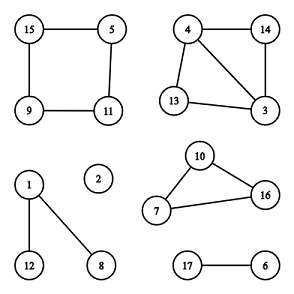CF977E.Cyclic Components
普及/提高-
通过率:0%
AC君温馨提醒
该题目为【codeforces】题库的题目,您提交的代码将被提交至codeforces进行远程评测,并由ACGO抓取测评结果后进行展示。由于远程测评的测评机由其他平台提供,我们无法保证该服务的稳定性,若提交后无反应,请等待一段时间后再进行重试。
题目描述
You are given an undirected graph consisting of n vertices and m edges. Your task is to find the number of connected components which are cycles.
Here are some definitions of graph theory.
An undirected graph consists of two sets: set of nodes (called vertices) and set of edges. Each edge connects a pair of vertices. All edges are bidirectional (i.e. if a vertex a is connected with a vertex b , a vertex b is also connected with a vertex a ). An edge can't connect vertex with itself, there is at most one edge between a pair of vertices.
Two vertices u and v belong to the same connected component if and only if there is at least one path along edges connecting u and v .
A connected component is a cycle if and only if its vertices can be reordered in such a way that:
- the first vertex is connected with the second vertex by an edge,
- the second vertex is connected with the third vertex by an edge,
- ...
- the last vertex is connected with the first vertex by an edge,
- all the described edges of a cycle are distinct.
A cycle doesn't contain any other edges except described above. By definition any cycle contains three or more vertices.
 There are 6 connected components, 2 of them are cycles: [7,10,16] and [5,11,9,15] .
There are 6 connected components, 2 of them are cycles: [7,10,16] and [5,11,9,15] .
输入格式
The first line contains two integer numbers n and m ( 1≤n≤2⋅105 , 0≤m≤2⋅105 ) — number of vertices and edges.
The following m lines contains edges: edge i is given as a pair of vertices vi , ui ( 1≤vi,ui≤n , ui=vi ). There is no multiple edges in the given graph, i.e. for each pair ( vi,ui ) there no other pairs ( vi,ui ) and ( ui,vi ) in the list of edges.
输出格式
Print one integer — the number of connected components which are also cycles.
输入输出样例
输入#1
5 4 1 2 3 4 5 4 3 5
输出#1
1
输入#2
17 15 1 8 1 12 5 11 11 9 9 15 15 5 4 13 3 13 4 3 10 16 7 10 16 7 14 3 14 4 17 6
输出#2
2
说明/提示
In the first example only component [3,4,5] is also a cycle.
The illustration above corresponds to the second example.